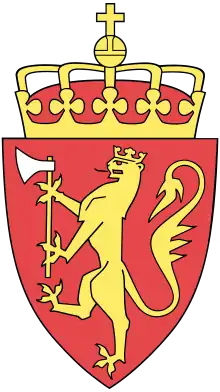Hornindal
Hornindal is a former municipality in the old Sogn og Fjordane county, Norway. It existed from 1867 until 1965 and then again from 1977 until 2020. It was located in the traditional district of Nordfjord. The administrative centre of the municipality was the village of Grodås. The municipality was located at the eastern end of the lake Hornindalsvatnet, the deepest lake in Northern Europe. The rest of the lake lies inside neighboring Eid Municipality.
Hornindal kommune | |
|---|---|
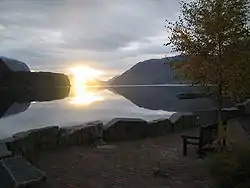 View of the lake Hornindalsvatnet | |
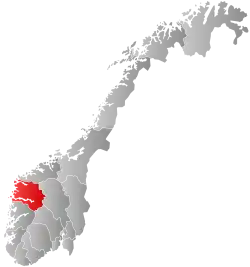 Sogn og Fjordane within Norway | |
 Hornindal within Sogn og Fjordane | |
| Coordinates: 61°59′55″N 06°35′03″E | |
| Country | Norway |
| County | Sogn og Fjordane |
| District | Nordfjord |
| Established | 1 Jan 1867–31 Dec 1965 |
| Re-established | 1 Jan 1977–31 Dec 2019 |
| Disestablished | 1 Jan 2020 |
| Administrative centre | Grodås |
| Government | |
| • Mayor (2015-2019) | Stig Olav Lødemel (H) |
| Area | |
| • Total | 191.60 km2 (73.98 sq mi) |
| • Land | 178.44 km2 (68.90 sq mi) |
| • Water | 13.16 km2 (5.08 sq mi) 6.9% |
| Area rank | 334 in Norway |
| *Area at municipal dissolution. | |
| Population (2018) | |
| • Total | 1,175 |
| • Rank | 381 in Norway |
| • Density | 6.6/km2 (17/sq mi) |
| • Change (10 years) | −3% |
| Demonym(s) | Horndøl[1] |
| Time zone | UTC+01:00 (CET) |
| • Summer (DST) | UTC+02:00 (CEST) |
| ISO 3166 code | NO-1444 |
| Official language form | Nynorsk[2] |
| Preceded by | Eid in 1867 |
| Succeeded by | Stryn in 1965 |
| Preceded by | Stryn in 1977 |
| Succeeded by | Volda in 2020 |
| Website | hornindal |
The European route E39 highway is ran through Hornindal Municipality as it made its route along the western coast of Norway. The Kviven Tunnel was completed in 2012 as part of the new E39 route connecting Hornindal to Volda Municipality in Møre og Romsdal county to the north. The tunnel was constructed to avoid the ferry crossing over the Voldsfjorden and it shortened the distance from Hornindal to Volda significantly.
At the time of its dissolution in 2020, the 192-square-kilometre (74 sq mi) municipality is the 334th largest by area out of the 422 municipalities in Norway. Hornindal is the 381st most-populous municipality in Norway, with a population of 1,175. The municipality's population density is 6.6 inhabitants per square kilometre (17/sq mi) and its population has decreased by 3% over the last decade.[3][4]
General information
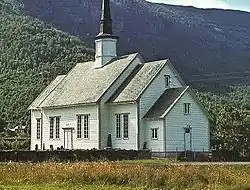
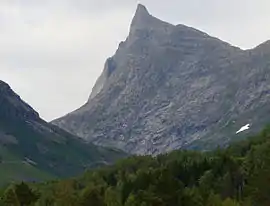
Since ancient times, Hornindal was a sub-parish (sokn) of Eid prestegjeld (see formannskapsdistrikt law). In 1865, Hornindal became a parish of its own and then two years later, on 1 January 1867, Hornindal was established as a separate municipality. At this time, Hornindal had a population of 1,612.[5]
During the 1960s, there were many municipal mergers across Norway due to the work of the Schei Committee. On 1 January 1965, the municipality of Hornindal was dissolved and it was divided between the neighboring municipalities of Eid and Stryn. Navelsaker and Holmøyvik and all of Hornindal west of there (population: 310) was transferred to Eid, and the 1,184 residents to the east of those areas went to Stryn. This, however, was not long-lasting. On 1 January 1977, the area of the old municipality of Hornindal was separated from Stryn and recreated as a separate municipality once again. The portions of Hornindal that were moved to Eid in 1964 remained there. The new Hornindal municipality had a population of 1,202.[5]
On 1 January 2019, the Maurset area in southern Hornindal (population: 19) was transferred from Hornindal to the neighboring municipality of Stryn.[6]
On 1 January 2020, Hornindal (in Sogn og Fjordane county) merged with the neighboring Volda Municipality and joined Møre og Romsdal county.[7]
Name
The municipality (originally the parish) was named after the old farm called Horne (Old Norse: Hornvin), since the first Hornindal Church was built there. The first element is horn which means "horn" (here referring to a pointed mountain behind the farm) and the last element is vin which means "meadow" or "pasture". So the meaning of the compounded name Hornindal is "the valley/dale of Horne".[8]
Coat of arms
The coat of arms was granted on 7 August 1987. They were designed by Petter Eide. It shows three silver blades of scythes on a blue background. Historically, farming and blacksmithing were vital industries in Hornindal. At one point, there were as many as 200 blacksmiths in the area. There was also a rich tradition of making handmade scythes and this was very symbolized by putting scythes on the coat-of-arms.[9][10]
Churches
The Church of Norway had one parish (sokn) within the municipality of Hornindal. It is part of the Nordfjord prosti (deanery) in the Diocese of Bjørgvin.
| Parish (sokn) | Church name | Location of the church | Year built |
|---|---|---|---|
| Hornindal | Hornindal Church | Grodås | 1856 |
Government
All municipalities in Norway, including Hornindal, are responsible for primary education (through 10th grade), outpatient health services, senior citizen services, unemployment and other social services, zoning, economic development, and municipal roads. The municipality is governed by a municipal council of elected representatives, which in turn elects a mayor.[11] The municipality falls under the Sogn og Fjordane District Court and the Gulating Court of Appeal.
Municipal council
The municipal council (Kommunestyre) of Hornindal was made up of 17 representatives that were elected to four-year terms. The party breakdown of the final municipal council was as follows:
| Party Name (in Nynorsk) | Number of representatives | |
|---|---|---|
| Labour Party (Arbeidarpartiet) | 4 | |
| Conservative Party (Høgre) | 5 | |
| Centre Party (Senterpartiet) | 6 | |
| Liberal Party (Venstre) | 2 | |
| Total number of members: | 17 | |
| Party Name (in Nynorsk) | Number of representatives | |
|---|---|---|
| Labour Party (Arbeidarpartiet) | 2 | |
| Conservative Party (Høgre) | 6 | |
| Centre Party (Senterpartiet) | 6 | |
| Liberal Party (Venstre) | 3 | |
| Total number of members: | 17 | |
| Party Name (in Nynorsk) | Number of representatives | |
|---|---|---|
| Labour Party (Arbeidarpartiet) | 3 | |
| Conservative Party (Høgre) | 6 | |
| Centre Party (Senterpartiet) | 4 | |
| Liberal Party (Venstre) | 4 | |
| Total number of members: | 17 | |
| Party Name (in Nynorsk) | Number of representatives | |
|---|---|---|
| Labour Party (Arbeidarpartiet) | 3 | |
| Conservative Party (Høgre) | 5 | |
| Centre Party (Senterpartiet) | 7 | |
| Liberal Party (Venstre) | 2 | |
| Total number of members: | 17 | |
| Party Name (in Nynorsk) | Number of representatives | |
|---|---|---|
| Labour Party (Arbeidarpartiet) | 3 | |
| Conservative Party (Høgre) | 6 | |
| Centre Party (Senterpartiet) | 6 | |
| Liberal Party (Venstre) | 2 | |
| Total number of members: | 17 | |
| Party Name (in Nynorsk) | Number of representatives | |
|---|---|---|
| Labour Party (Arbeidarpartiet) | 3 | |
| Conservative Party (Høgre) | 4 | |
| Centre Party (Senterpartiet) | 7 | |
| Liberal Party (Venstre) | 3 | |
| Total number of members: | 17 | |
| Party Name (in Nynorsk) | Number of representatives | |
|---|---|---|
| Labour Party (Arbeidarpartiet) | 3 | |
| Conservative Party (Høgre) | 3 | |
| Centre Party (Senterpartiet) | 7 | |
| Liberal Party (Venstre) | 3 | |
| Total number of members: | 17 | |
| Party Name (in Nynorsk) | Number of representatives | |
|---|---|---|
| Labour Party (Arbeidarpartiet) | 4 | |
| Conservative Party (Høgre) | 3 | |
| Centre Party (Senterpartiet) | 6 | |
| Liberal Party (Venstre) | 3 | |
| Local list for Kjøs area (Grendaliste for Kjøs krins) | 1 | |
| Total number of members: | 17 | |
| Party Name (in Nynorsk) | Number of representatives | |
|---|---|---|
| Labour Party (Arbeidarpartiet) | 4 | |
| Conservative Party (Høgre) | 3 | |
| Centre Party (Senterpartiet) | 6 | |
| Liberal Party (Venstre) | 4 | |
| Total number of members: | 17 | |
| Party Name (in Nynorsk) | Number of representatives | |
|---|---|---|
| Labour Party (Arbeidarpartiet) | 4 | |
| Conservative Party (Høgre) | 3 | |
| Centre Party (Senterpartiet) | 6 | |
| Common list for Hornindal (Samlingslista for Hornindal) | 4 | |
| Total number of members: | 17 | |
| Party Name (in Nynorsk) | Number of representatives | |
|---|---|---|
| Labour Party (Arbeidarpartiet) | 4 | |
| Centre Party (Senterpartiet) | 6 | |
| Liberal Party (Venstre) | 5 | |
| Local List(s) (Lokale lister) | 2 | |
| Total number of members: | 17 | |
| Party Name (in Nynorsk) | Number of representatives | |
|---|---|---|
| Labour Party (Arbeidarpartiet) | 5 | |
| Liberal Party (Venstre) | 3 | |
| Joint List(s) of Non-Socialist Parties (Borgarlege Felleslister) | 5 | |
| Local List(s) (Lokale lister) | 4 | |
| Total number of members: | 17 | |
| Party Name (in Nynorsk) | Number of representatives | |
|---|---|---|
| Labour Party (Arbeidarpartiet) | 6 | |
| Conservative Party (Høgre) | 1 | |
| Farmers' Party (Bondepartiet) | 5 | |
| Liberal Party (Venstre) | 2 | |
| Local List(s) (Lokale lister) | 3 | |
| Total number of members: | 17 | |
| Party Name (in Nynorsk) | Number of representatives | |
|---|---|---|
| Labour Party (Arbeidarpartiet) | 4 | |
| Liberal Party (Venstre) | 3 | |
| Local List(s) (Lokale lister) | 9 | |
| Total number of members: | 16 | |
| Party Name (in Nynorsk) | Number of representatives | |
|---|---|---|
| Labour Party (Arbeidarpartiet) | 3 | |
| Liberal Party (Venstre) | 4 | |
| Local List(s) (Lokale lister) | 9 | |
| Total number of members: | 16 | |
| Party Name (in Nynorsk) | Number of representatives | |
|---|---|---|
| Liberal Party (Venstre) | 4 | |
| List of workers, fishermen, and small farmholders (Arbeidarar, fiskarar, småbrukarar liste) | 5 | |
| Local List(s) (Lokale lister) | 7 | |
| Total number of members: | 16 | |
| Party Name (in Nynorsk) | Number of representatives | |
|---|---|---|
| Labour Party (Arbeidarpartiet) | 3 | |
| Joint List(s) of Non-Socialist Parties (Borgarlege Felleslister) | 5 | |
| Local List(s) (Lokale lister) | 8 | |
| Total number of members: | 16 | |
Mayor
The mayor (ordførar) of a municipality in Norway is a representative of the majority party of the municipal council who is elected to lead the council. Stig Olav Lødemel of the Conservative Party was elected mayor for the 2015–2019 term.[26]
Geography
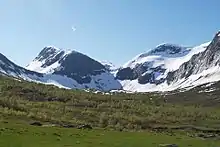
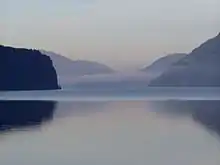
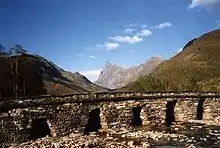
Location
Hornindal is located on the northern border of Sogn og Fjordane county. Hornindal is bordered to the west by the municipality of Eid, to the south by Stryn, to the east by Stranda (in Møre og Romsdal county), and to the north by Ørsta and Volda (both in Møre og Romsdal county).
Mountains
- Hornindalsrokken mountain (1,495 metres or 4,905 feet)
- Gulkoppen mountain (1,304 metres or 4,278 feet)
- Middagsfjellet (903 metres or 2,963 feet)
Attractions
Hornindalsvatnet
The Hornindalsvatnet lake is the deepest lake in Europe at 514 metres (1,686 ft) deep. None of the glacier streams run out into the lake and this has resulted in one of Europe's clearest lakes.[27]
Anders Svor Museum
Anders Svor was born in 1864 on the Svor Farm in Hornindal. At the age of 21 he left for Denmark where he enrolled at the Copenhagen Academy of Art. He later participated in many art exhibitions in Kristiania, Copenhagen, Paris, and Chicago. The Anders Svor Museum was opened in 1953 and features 450 of his works. His art is characterised by simple, clean lines, and deep authenticity.[28]
Famous people
- Frode Grodås, (born 1964), footballer
- Bjørn Lødemel (born 1958), politician
- Brita Lund, (1886–1966), artist
- Anders Svor, (1864–1929), sculptor
- Anders Fannemel, (born 1991), ski jumper
References
- "Navn på steder og personer: Innbyggjarnamn" (in Norwegian). Språkrådet.
- "Forskrift om målvedtak i kommunar og fylkeskommunar" (in Norwegian). Lovdata.no.
- Statistisk sentralbyrå (2018). "Table: 06913: Population 1 January and population changes during the calendar year (M)" (in Norwegian). Retrieved 29 September 2019.
- Statistisk sentralbyrå. "09280: Area of land and fresh water (km²) (M)" (in Norwegian). Retrieved 29 September 2019.
- Juvkam, Dag (1999). "Historisk oversikt over endringer i kommune- og fylkesinndelingen" (PDF) (in Norwegian). Statistics Norway. Cite journal requires
|journal=(help) - "Justering av grensa mellom kommunane Stryn og Hornindal" (in Norwegian). Kommunal- og moderniseringsdepartementet. 1 December 2018. Retrieved 29 April 2019.
- "Nye Volda" (in Norwegian). Retrieved 22 October 2017.
- Rygh, Oluf (1919). Norske gaardnavne: Nordre Bergenhus amt (in Norwegian) (12 ed.). Kristiania, Norge: W. C. Fabritius & sønners bogtrikkeri. pp. 448–449.
- Tvinnereim, Jarle (24 April 2008). "Kommunevåpenet til Hornindal" (in Norwegian). Archived from the original on 26 February 2012. Retrieved 21 July 2008.
- "Civic heraldry of Norway – Norske Kommunevåpen". Heraldry of the World. Retrieved 22 October 2017.
- Hansen, Tore, ed. (12 May 2016). "kommunestyre". Store norske leksikon (in Norwegian). Kunnskapsforlaget. Retrieved 6 March 2019.
- "Table: 04813: Members of the local councils, by party/electoral list at the Municipal Council election (M)" (in Norwegian). Statistics Norway.
- "Tall for Norge: Kommunestyrevalg 2011 - Sogn og Fjordane" (in Norwegian). Statistics Norway. Retrieved 19 October 2019.
- "Kommunestyrevalget 1995" (PDF) (in Norwegian). Oslo-Kongsvinger: Statistisk sentralbyrå. 1996. Retrieved 16 February 2020.
- "Kommunestyrevalget 1991" (PDF) (in Norwegian). Oslo-Kongsvinger: Statistisk sentralbyrå. 1993. Retrieved 16 February 2020.
- "Kommunestyrevalget 1987" (PDF) (in Norwegian). Oslo-Kongsvinger: Statistisk sentralbyrå. 1988. Retrieved 16 February 2020.
- "Kommunestyrevalget 1983" (PDF) (in Norwegian). Oslo-Kongsvinger: Statistisk sentralbyrå. 1984. Retrieved 1 May 2020.
- "Kommunestyrevalget 1979" (PDF) (in Norwegian). Oslo: Statistisk sentralbyrå. 1979. Retrieved 10 May 2020.
- "Kommunevalgene 1963" (PDF) (in Norwegian). Oslo: Statistisk sentralbyrå. 1964. Retrieved 10 May 2020.
- "Kommunevalgene og Ordførervalgene 1959" (PDF) (in Norwegian). Oslo: Statistisk sentralbyrå. 1960. Retrieved 10 May 2020.
- "Kommunevalgene og Ordførervalgene 1955" (PDF) (in Norwegian). Oslo: Statistisk sentralbyrå. 1957. Retrieved 10 May 2020.
- "Kommunevalgene og Ordførervalgene 1951" (PDF) (in Norwegian). Oslo: Statistisk sentralbyrå. 1952. Retrieved 10 May 2020.
- "Kommunevalgene og Ordførervalgene 1947" (PDF) (in Norwegian). Oslo: Statistisk sentralbyrå. 1948. Retrieved 10 May 2020.
- "Kommunevalgene og Ordførervalgene 1945" (PDF) (in Norwegian). Oslo: Statistisk sentralbyrå. 1947. Retrieved 10 May 2020.
- "Kommunevalgene og Ordførervalgene 1937" (PDF) (in Norwegian). Oslo: Statistisk sentralbyrå. 1938. Retrieved 11 May 2020.
- Hornindal Kommune. "Presentasjon av ordførar Stig Olav Lødemel" (in Norwegian). Retrieved 22 October 2017.
- "Hornindal Municipality in Norway". GoNorway.com. Retrieved 21 July 2008.
- "Anders Svor Museum, Hornindal". 13 August 2007. Retrieved 21 July 2008.
External links
- Municipal fact sheet from Statistics Norway (in Norwegian)
- Official website of Hornindal (in Norwegian)
- NRK: Hornindal (in Norwegian)
- Webcam in Hornindal (in Norwegian)

